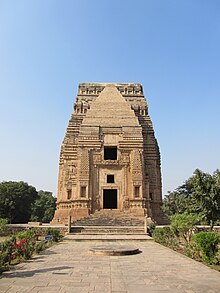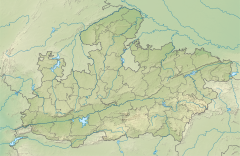Teli ka Mandir
| Teli ka Mandir | |
|---|---|
 Front view of the temple | |
| Religion | |
| Affiliation | Hinduism |
| District | Gwalior |
| Deity | Shiva, Vishnu, others |
| Location | |
| Location | Gwalior Fort |
| State | Madhya Pradesh |
| Country | India |
| Geographic coordinates | 26°13′15.2″N 78°09′53.6″E / 26.220889°N 78.164889°E |
| Architecture | |
| Style | Nagara |
| Completed | 8th or 9th-century[1][2] |
Teli ka Mandir, also known as Telika Temple, is a Hindu temple located within the Gwalior Fort in Madhya Pradesh, India. Dedicated to Shiva, Vishnu and Matrikas, it has been variously dated between the early 8th and early 9th century CE.[1][2]
It is an atypical design for a Hindu temple,[1] as it has a rectangular sanctum instead of the typical square. It integrates the architectural elements of the Nagara style and the Valabhi prasada. The temple is based on a Gurjara Pratihara-Gopagiri style North Indian architecture.[3][4][5]
The temple is a classic example of a design based on "musical harmonics" in architecture,[6] one that Hermann Goetz called as a masterpiece of late Gupta era Indian art.[7]
Location
The temple is located inside the fort of Gwalior, north Madhya Pradesh. The city is connected by major highways NH 44 and 46 (Asian Highway 43 and 47), a railway station and airport (
The Telika Mandir is one of the historic temples within the Gwalior old city. It is in the middle of the old town, built on a high point which makes it stand out from different locations within the fort.[12][2][13] The site of the Teli ka Mandir and other historic temples is found in early inscriptions. Some of these refer to the town as Gopagiri.[14]
History
The Telika Mandir is generally dated to between 8th and 9th century based on paleography, art-style, architectural design and small inscriptions found within the temple premises.
The temple shows signs of extensive damage and change.[2] It was badly damaged in the plunder raids by Muslim army of Qutb-ud-din Aibak and his successor Iltutmish in 1232 CE along with other temples in the fort following a jauhar, parts of the ruins were then used to apparently build a mosque nearby. The mosque was in turn apparently destroyed by Hindu Maratha army centuries later.[17] The temple was restored by the Hindus after the desecration by Iltutmish forces, which speculated Cunningham, may explain some of the features that appear from a later era.[12] The temple has icons and inscriptions related to all three major traditions of Hinduism: Shaivism, Vaishnavism and Shaktism. One of the inscriptions, for example, is a metrical hymn about Durga.[14] The relief work includes a prominent Garuda, the vahana of Vishnu. Inside the temple is a Shiva linga.[12]
The temple was in ruins in the 19th century. Between 1881 and 1883, repairs to the temple were initiated by Major Keith, an officer of the
Nomenclature
The origin of the temple's name is unclear. It literally means Oilman's Temple, but neither the inscriptions nor texts attest to such a name. According to Allen, there is no satisfactory explanation for this name.[2] Local folklore states that the temple was built by oil merchant caste rather than kings, the royal class or the priestly class.[20]
Description

The temple has a rectangular triratha sanctum plan that sits on a jagati platform that is a square of 60 feet (18 m). It has a large kapili projecting portico of about 11 feet (3.4 m) towards the east. The tower rises about the rectangular sanctum to a height of 80 feet (24 m). Above it is a barrel vault shaped cap of 30 feet (9.1 m), its length perpendicular to that of the sanctum, that reminds one of South Indian gopuram.[12] It likely had amalaka, kalasha and other ornaments on top, but these are all lost to history. The walls of temple has numerous niches for statues, but it is all empty now and show signs of damage.[2][7] The niches are topped by tall pediments.[22][23] The outer dimensions of the sanctum are 60x40 feet with an 80 feet tower above.[2]
The doorway into the temple is 35 feet (11 m) high, and it is ornate. Above the doorway is a relief of Garuda, the vahana of Vishnu. Inside, there is another doorway above which is a Ganesha relief.
The temple is approached through a flight of stairs leading to a banded doorway containing sculptures of river goddesses Ganga and Yamuna with their waists leaning towards the center, each with a boy and a girl on the lower part. Above them are amorous couples in various stages of courtship and intimacy (
The temple's vallabhi shikhara mirrors the gopuram of Dravidian temples and it stands on a Nagara base.[26] The temple's outer walls have been extensively carved.
Analysis and reception
The Teli ka mandir is unusual in many ways, and its complex design has led to many contesting proposals for what influenced it or which temples it influenced. Proposals range from it being influenced by Buddhist architecture,[2] or by South Indian temples, or it being an independent masterpiece innovation of the late Gupta era Hindu artists.[7]
The temple sanctum plan seems rectangular rather than the typical square, one that makes it the oldest surviving Hindu temple with a rectangular plan in Central India. According to Michael Meister, a professor specializing on Indian temple architecture, the temple is actually a study in squares nevertheless because its rectangles are formed by combining squares.
The Teli ka temple of Gwalior is closest in its plan to a 4x4 square grid, yet different. According to Michael Meister this innovation is carried across the temple deliberately in its Bhadra, Pratibhadra, Karna, Kapota, Kumbha, Bhitta and other elements,[6]
The Teli-ka-mandir enlarges such a grid by increasing the sanctum, not the entire structure, by 50 percent (from 4x4 to 4x6 squares, a ratio of 2: 3), thus enlarging the outer dimensions from 8x8 to 8x10 squares (a ratio of 4:5). The ratio of the thickness of wall to sanctum is 1:2 on the temple's shorter sides, 1:3 on the longer wall. Ratios that emerge from this analysis of the Teli-ka-mandir's plan thus include 1:1, 1:2, 1:3, 2:3, and 3:5 as well as 2:5 and 4:5. These simple ratios governing the plan and created by the grid might be compared to harmonic ratios. I know of no evidence to suggest a deep commitment in India to "musical" harmonies in architecture; yet few structures better embody harmonious proportions than the eighth-century Teli-ka-mandir.[6]
Gallery
-
Ruined Jain sculptures at 8th century Teli ka Mandir
-
View of the Teli-ka-mandir
-
Defaced yet decipherable river goddess (eastern entrance)
-
The lion capital in theVardhana-period.[29]
See also
References
- ^ ISBN 978-0-226-53230-1.
- ^ ISBN 978-0-87413-399-8.
- ^ ISBN 978-0-8122-7840-8.
- ISBN 978-81-208-0824-9.
- ^ ISBN 978-1-4438-6734-4.
- ^ a b c Michael W. Meister (1983), Geometry and Measure in Indian Temple Plans: Rectangular Temples, Artibus Asiae, Vol. 44, No. 4 (1983), page 269, 278-280
- ^ a b c d e f g Herman Goetz (1955), The Last Masterpiece of Gupta Art: The Great Temple of Yasovarman of Kanauj ('Telika Mandir') at Gwalior, Art and Letters, Vol. XXIX, No. 2, pages 47-59
- ^ Group of temples at Batesar , ASI Bhopal Circle (2014)
- ^ Naresar Temples, ASI Bhopal Circle (2014)
- ISBN 978-0-87413-399-8.
- ISBN 90-04-12902-2.
- ^ a b c d e Teli Mandir, A Cunningham, pages 356-361
- ISBN 978-0-9548480-2-6.
- ^ a b c Gwalior Fort: Gwalior, ASI Bhopal Circle, Government of India
- ^ Michael W. Meister (1983), Geometry and Measure in Indian Temple Plans: Rectangular Temples, Artibus Asiae, Vol. 44, No. 4 (1983), page 267 with footnote 11
- ^ ISBN 978-81-263-1155-2.
- ^ Hermann Goetz; Hermann Kulke (1974). Studies in the history, religion and art of classical and mediaeval India. Steiner. p. 61.
- ^ "Panoramic past". Frontline. 17 May 2013. Retrieved 11 December 2014.
- ^ India. Curator of Ancient Monuments; Henry Hardy Cole (1882). Report of the Curator of Ancient Monuments in India. Government Central Branch Press. p. 17.
- ^ ISBN 978-93-80262-49-9.
- ^ Michael W. Meister (1983), Geometry and Measure in Indian Temple Plans: Rectangular Temples, Artibus Asiae, Vol. 44, No. 4 (1983), page 278, context: 266-296
- ISBN 978-1-59339-847-7.
- ISBN 978-1-61530-149-2.
- ISSN 0970-8901.
- ISBN 978-81-85151-16-8.
- ^ "Gwalior Fort". Archaeological Survey of India. Retrieved 11 December 2014.
- Vardhana attribution by the Indian Museum in New Delhi, see label of the lion capital
- ^ a b c d Michael W. Meister (1983), Geometry and Measure in Indian Temple Plans: Rectangular Temples, Artibus Asiae, Vol. 44, No. 4 (1983), pages 266-296
- Vardhana attribution by the Indian Museum in New Delhi, see label of the lion capital
Bibliography
- Prasanna Kumar Acharya (2010). An encyclopaedia of Hindu architecture. Oxford University Press (Republished by Motilal Banarsidass). ISBN 978-81-7536-534-6.
- Prasanna Kumar Acharya (1997). A Dictionary of Hindu Architecture: Treating of Sanskrit Architectural Terms with Illustrative Quotations. Oxford University Press (Reprinted in 1997 by Motilal Banarsidass). ISBN 978-81-7536-113-3.
- Vinayak Bharne; Krupali Krusche (2014). Rediscovering the Hindu Temple: The Sacred Architecture and Urbanism of India. Cambridge Scholars Publishing. ISBN 978-1-4438-6734-4.
- Alice Boner (1990). Principles of Composition in Hindu Sculpture: Cave Temple Period. Motilal Banarsidass. ISBN 978-81-208-0705-1.
- Alice Boner; Sadāśiva Rath Śarmā (2005). Silpa Prakasa. Brill Academic (Reprinted by Motilal Banarsidass). ISBN 978-8120820524.
- A.K. Coomaraswamy; Michael W. Meister (1995). Essays in Architectural Theory. Indira Gandhi National Centre for the Arts. ISBN 978-0-19-563805-9.
- Dehejia, V. (1997). Indian Art. Phaidon: London. ISBN 0-7148-3496-3.
- Adam Hardy (1995). Indian Temple Architecture: Form and Transformation. Abhinav Publications. ISBN 978-81-7017-312-0.
- Adam Hardy (2007). The Temple Architecture of India. Wiley. ISBN 978-0470028278.
- Adam Hardy (2015). Theory and Practice of Temple Architecture in Medieval India: Bhoja's Samarāṅgaṇasūtradhāra and the Bhojpur Line Drawings. Indira Gandhi National Centre for the Arts. ISBN 978-93-81406-41-0.
- Harle, J.C., The Art and Architecture of the Indian Subcontinent, 2nd edn. 1994, Yale University Press Pelican History of Art, ISBN 0300062176
- Monica Juneja (2001). Architecture in Medieval India: Forms, Contexts, Histories. Orient Blackswan. ISBN 978-8178242286.
- Stella Kramrisch (1976). The Hindu Temple Volume 1. Motilal Banarsidass (Reprinted 1946 Princeton University Press). ISBN 978-81-208-0223-0.
- Stella Kramrisch (1979). The Hindu Temple Volume 2. Motilal Banarsidass (Reprinted 1946 Princeton University Press). ISBN 978-81-208-0224-7.
- Michael W. Meister; Madhusudan Dhaky (1986). Encyclopaedia of Indian temple architecture. American Institute of Indian Studies. ISBN 978-0-8122-7992-4.
- George Michell (1988). The Hindu Temple: An Introduction to Its Meaning and Forms. University of Chicago Press. ISBN 978-0-226-53230-1.
- George Michell (2000). Hindu Art and Architecture. Thames & Hudson. ISBN 978-0-500-20337-8.
- T. A. Gopinatha Rao (1993). Elements of Hindu iconography. Motilal Banarsidass. ISBN 978-81-208-0878-2.
- Ajay J. Sinha (2000). Imagining Architects: Creativity in the Religious Monuments of India. University of Delaware Press. ISBN 978-0-87413-684-5.
- Burton Stein (1978). South Indian Temples. Vikas. ISBN 978-0706904499.
- Burton Stein (1989). The New Cambridge History of India: Vijayanagara. Cambridge University Press. ISBN 978-0-521-26693-2.
- Burton Stein; David Arnold (2010). A History of India. John Wiley & Sons. ISBN 978-1-4443-2351-1.
- Kapila Vatsyayan (1997). The Square and the Circle of the Indian Arts. Abhinav Publications. ISBN 978-81-7017-362-5.











![The lion capital in the National Museum, New Delhi, attributed by the museum to the Vardhana-period.[29]](http://upload.wikimedia.org/wikipedia/commons/thumb/a/a2/Indian_Stone_Statue-_Lion_Capital%2C_Vardhana_7th_Century_CE_Gwalior.jpg/160px-Indian_Stone_Statue-_Lion_Capital%2C_Vardhana_7th_Century_CE_Gwalior.jpg)